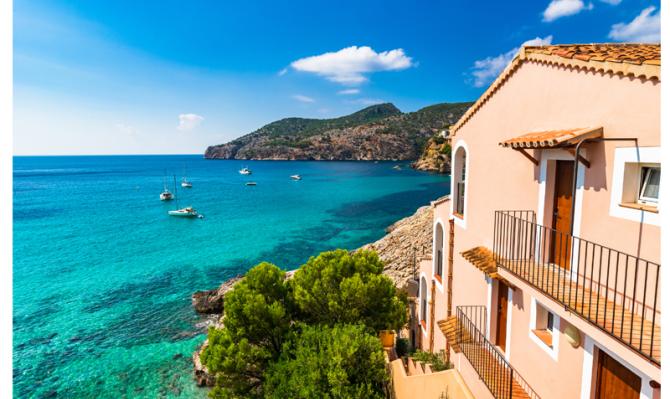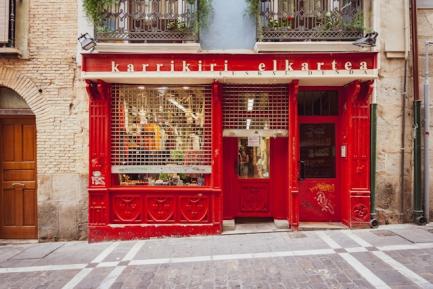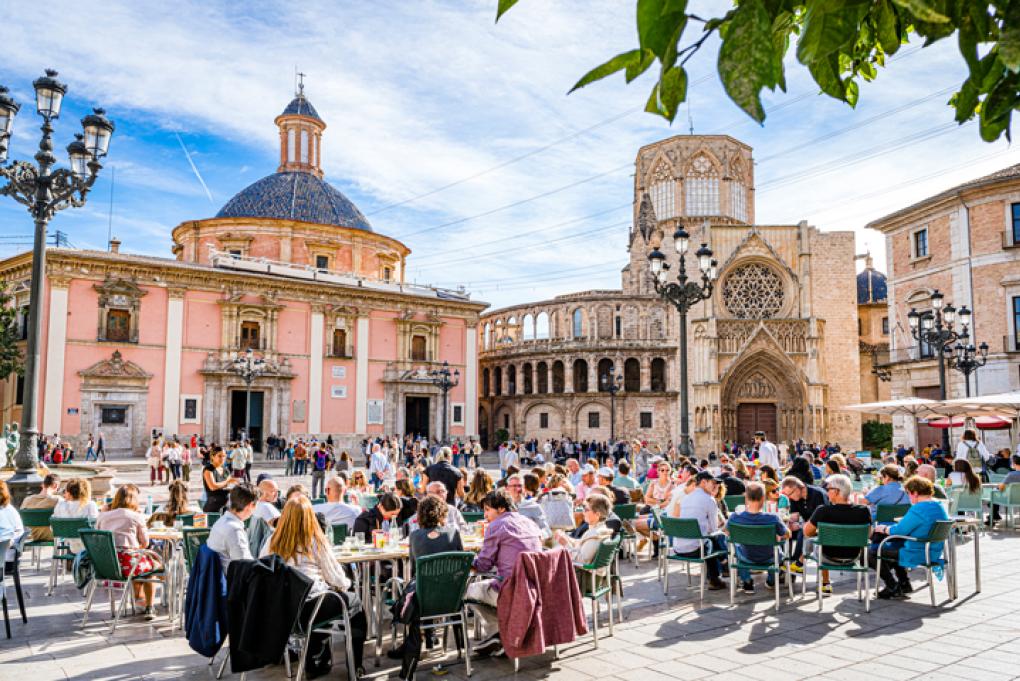What does big data tell us about foreigners who spend long periods in Spain?
We use internal data to analyse the behaviour of foreign visitors who stay in Spain for long periods of time. This is a segment of the population that tends to stay in second homes, seasonal rental homes or specialist accommodation – segments that are experiencing rising demand in Spain’s real estate market.

Foreign visitors who stay in Spain for long periods of time are an important group of the population for the real estate market since they usually stay in second homes, seasonal rental homes or specialised accommodation (student residences or new forms of housing such as flex living or co-living), which are segments that are experiencing rising demand in Spain. In order to characterise their spending patterns and the areas they tend to frequent, we have analysed data on foreign card payments recorded on CaixaBank POS terminals, identifying international tourists who visited Spain in 2023 for a relatively long period of time, specifically between 3 and 11 months. Their contribution to total foreign card spending is very significant and has grown rapidly in recent years.
Spain’s major cities and some tourist areas are transforming with the arrival of foreigners who visit Spain for extended periods of time, whether they own a second home or they come to work (digital nomads, displaced workers), to study or to pursue other activities. There has been significant growth in these types of visitors in recent years, especially since the pandemic, and this is having a significant impact on the housing market in the areas where they are concentrated.
The arrival of long-term foreign visitors is having a significant impact on the housing market
In order to analyse the differentiated behaviour of this group of foreigners and where they are located, we use data on foreign card payments recorded on CaixaBank POS terminals and identify cards with expenditure in at least 30 days over a minimum of 3 different months and a maximum of 11 months in a calendar year.16 In 2023, 1% of foreign cards meet this definition, and we will refer to them «foreigners with local ties».17 The remaining 99% of foreign cards correspond to tourists who had a shorter stay in Spain, or «sporadic foreign visitors» (visits lasting less than 3 months and/or with payments in fewer than 30 days throughout the year).
Although international visitors with local ties account for a small percentage of all foreign cards, their contribution to the total expenditure made by such cards is very high, at 8.8% in 2023. Moreover, this contribution has grown significantly since 2019, when they accounted for 0.8% of the number of cards and contributed 6.9% of the total expenditure carried out with foreign cards. The arrival of foreigners has been encouraged by favourable regulation and taxation.18
In the following chart, we can see that the spending of foreigners with local ties is distributed fairly evenly throughout the year, showing a lower seasonality than foreign cards associated with short-stay visitors. The difference is particularly pronounced during the summer months.
- 16. We do not consider foreign cards that are observed in all 12 months of the year, in order to exclude foreigners who may have a more permanent residential link to Spain. The available data (payment transactions) do not allow us to distinguish between residents and non-residents in Spain. For tax purposes, a person is considered to be resident if they spend more than 183 days in Spain during the calendar year.
- 17. Although this definition does not correspond to that of the Spanish National Statistics Institute (INE), conceptually we are seeking to identify the population with local ties (or the «transient population»), which according to the INE is defined as the set of people who have some kind of connection with a given municipality because they either reside there, work or study there, or tend to spend certain times of the year there (holidays, weekends, etc.). Informally they are often referred to as expats, to describe foreigners who migrate out of choice, rather than fleeing hardship in their country, and who are generally highly qualified and have a high purchasing power.
- 18. E.g. tax benefits under the so-called Beckham Law (special tax regime for expats), the granting of Golden Visas for real estate investors (currently being eliminated), visas for digital nomads (international teleworkers) or those for foreign investors through the so-called Startups Act.
International visitors with local ties make much longer stays (48 days on average versus 2.8 days in the case of sporadic tourists). Although their daily expenditure is lower than that of short-stay foreign tourists (35 euros per day compared to 64 for sporadic tourists),19 their total expenditure per card is substantially higher (1,729 euros vs. 180 euros). It is important to note that these figures, which are based on all the transactions observed, should be interpreted as an approximation of the total expenditure and of the duration of the entire stay. For instance, foreigners also make purchases on POS terminals of other banks, they may use several cards or have cards issued by another Spanish bank, and there may be days when they are in Spain but do not make any payments on CaixaBank POS terminals. On the other hand, there may be permanent residents in Spain or people with Spanish nationality who possess foreign cards and use them sporadically.
- 19. Aggregate expenditure data per card. The length of the stay of each card is defined based on the number of days on which transactions with that card are observed.
Although the daily expenditure of international visitors with local ties is lower than that of short-stay tourists, their total expenditure per card is substantially higher
Foreigners with local ties have a high total expenditure due to the longer duration of their stays
If we analyse the composition of the spending recorded by each type of card, we note that foreigners with local ties spend a lot in supermarkets (25% of the total). This is a similar level to Spanish cards (33%) and much higher than that of sporadic foreign visitors (10%). In contrast, their spending at catering establishments (25% of the total) is more similar to that of sporadic foreign visitors (27%) than to that of Spaniards (15%). On the other hand, the relative weight of hotel spending (5%) is much lower than it is for sporadic tourists (27%), but it is still twice that of Spaniards (2.4%). These statistics allow us to build a profile of these types of visitors who spend relatively long periods in Spain: they show a similar level of spending on essential products to that of Spaniards, but a greater willingness to travel and, above all, to enjoy gastronomy during their stay.
Visitors who stay longer show a similar level of spending on essential products to that of Spaniards, but a greater willingness to travel and, above all, to enjoy gastronomy during their stay
Foreigners with local ties show a high level of expenditure in supermarkets and restaurants
Distribution of expenditure by type of card (% of total expenditure)
It comes as no surprise that the ranking of linked foreigners is headed by French, British and American, a list very similar to that of foreign home buyers in Spain
By nationality, the French, British and Americans lead the ranking of foreigners with local ties. It comes as no surprise that this list is very similar to that of foreign home buyers in Spain, which corroborates the hypothesis that many of these cards correspond to foreigners who own a second home in the country. If we look at the weight of foreign cards with local ties relative to the total number of cards (remember, this percentage increased from 0.8% in 2019 to 1.0% in 2023), we see that some nationalities account for an above-average portion and that that portion has grown significantly between 2019 and 2023. Ukraine is the nationality that stands out the most, for obvious reasons linked to the movements triggered by Russia’s invasion (5.7% of Ukrainian cards are classified as having local ties and they account for 32% of the expenditure made with cards issued by this country in 2023, whereas in 2019 their presence was negligible). Also noteworthy are certain Latin American nationalities such as Mexico, Colombia and Argentina, whose presence in Spain has increased substantially since the pandemic.

As can be seen in the map, foreigners with local ties are concentrated on the islands, along the Mediterranean coast, especially in Alicante (the province with the highest percentage of property sales involving foreign buyers) and Murcia, in some of the major urban areas such as Madrid, Barcelona, Zaragoza and Seville, as well as other provincial capitals such as Córdoba, Cáceres, Badajoz and Gijón, among others.

Some of the foreigners who visit our country for relatively long periods have a significantly higher purchasing power than the Spanish average. These foreigners usually choose to buy high-value homes, a segment that is attracting significant interest in certain locations such as Madrid, the Balearic Islands, Malaga and Barcelona.20 To analyse this market segment, we selected the 5% of foreign cards with local ties that had the highest level of aggregate spending. The map on the next page shows the municipalities in which the spending with these cards is recorded. The granularity of the data allows us to identify where the largest number of high-expenditure cards are concentrated. This list is topped by Ibiza town, the neighbourhood of Salamanca in Madrid, three districts in the centre of Palma de Mallorca, Sant Gervasi-La Bonanova in Barcelona, and Jávea and Orihuela in Alicante.
- 20. According to several real estate consulting firms, the luxury housing market is enjoying a boom in Spain, attracting the interest of investors, developers and clients. Within this market, branded residences (generally associated with a hotel, offering exceptional services in unique locations) are the flagship product.

Unfortunately, the available card transaction data do not allow us to determine in what type of accommodation the foreigners with local ties we have analysed stay in. However, it is to be expected that a significant proportion of them will do so in their second homes in Spain. In the chart on the following page, we show a positive and very close relationship between the percentage of sales involving foreign buyers (as a percentage of all sales in the province) and the density of foreign cards with local ties (as a percentage of the population of the province) in 2023. Unsurprisingly, the most touristy provinces have high values in both metrics.
The available data do not allow us to determine in what type of accommodation the foreigners with local ties stay in, but it is to be expected that a significant portion of them will do so in their second homes

On the other hand, for foreigners with local ties who do not own a second home, a new type of specialised accommodation is emerging to cover temporary accommodation needs. On the one hand, we find segments such as student residences, which are usually linked to universities themselves and remain in short supply despite the recent growth.21 On the other hand, we find new forms of accommodation such as flex living and co-living which also tend to offer temporary rentals. This is a hybrid concept between a hotel and a residential building, which is managed professionally and offers access to services (common areas, gym, barbecue, etc.) and belongs to a community of residents. This segment is currently experiencing rapid growth in Spain due to high demand, since it is well suited to meet emerging needs and new realities in society, as well as growing supply thanks to the appetite shown by investors for this type of property.22
- 21. See «Tendencias CBRE en Living 2024» and «The Flex living market in Spain», JLL, May 2024.
- 22. According to the real estate consulting firm CBRE, the stock of flex living accommodation has increased four-fold since 2020 and is expected to reach 23,000 beds by 2026. According to JLL, Madrid is the Spanish city with the largest offer of flex living, with 6,000 beds available and an expected future supply of 16,000. It is followed Barcelona, with around 2,300 beds today and some 2,600 in the pipeline.
- 16. We do not consider foreign cards that are observed in all 12 months of the year, in order to exclude foreigners who may have a more permanent residential link to Spain. The available data (payment transactions) do not allow us to distinguish between residents and non-residents in Spain. For tax purposes, a person is considered to be resident if they spend more than 183 days in Spain during the calendar year.
- 17. Although this definition does not correspond to that of the Spanish National Statistics Institute (INE), conceptually we are seeking to identify the population with local ties (or the «transient population»), which according to the INE is defined as the set of people who have some kind of connection with a given municipality because they either reside there, work or study there, or tend to spend certain times of the year there (holidays, weekends, etc.). Informally they are often referred to as expats, to describe foreigners who migrate out of choice, rather than fleeing hardship in their country, and who are generally highly qualified and have a high purchasing power.
- 18. E.g. tax benefits under the so-called Beckham Law (special tax regime for expats), the granting of Golden Visas for real estate investors (currently being eliminated), visas for digital nomads (international teleworkers) or those for foreign investors through the so-called Startups Act.
- 19. Aggregate expenditure data per card. The length of the stay of each card is defined based on the number of days on which transactions with that card are observed.
- 20. According to several real estate consulting firms, the luxury housing market is enjoying a boom in Spain, attracting the interest of investors, developers and clients. Within this market, branded residences (generally associated with a hotel, offering exceptional services in unique locations) are the flagship product.
- 21. See «Tendencias CBRE en Living 2024» and «The Flex living market in Spain», JLL, May 2024.
- 22. According to the real estate consulting firm CBRE, the stock of flex living accommodation has increased four-fold since 2020 and is expected to reach 23,000 beds by 2026. According to JLL, Madrid is the Spanish city with the largest offer of flex living, with 6,000 beds available and an expected future supply of 16,000. It is followed Barcelona, with around 2,300 beds today and some 2,600 in the pipeline.



